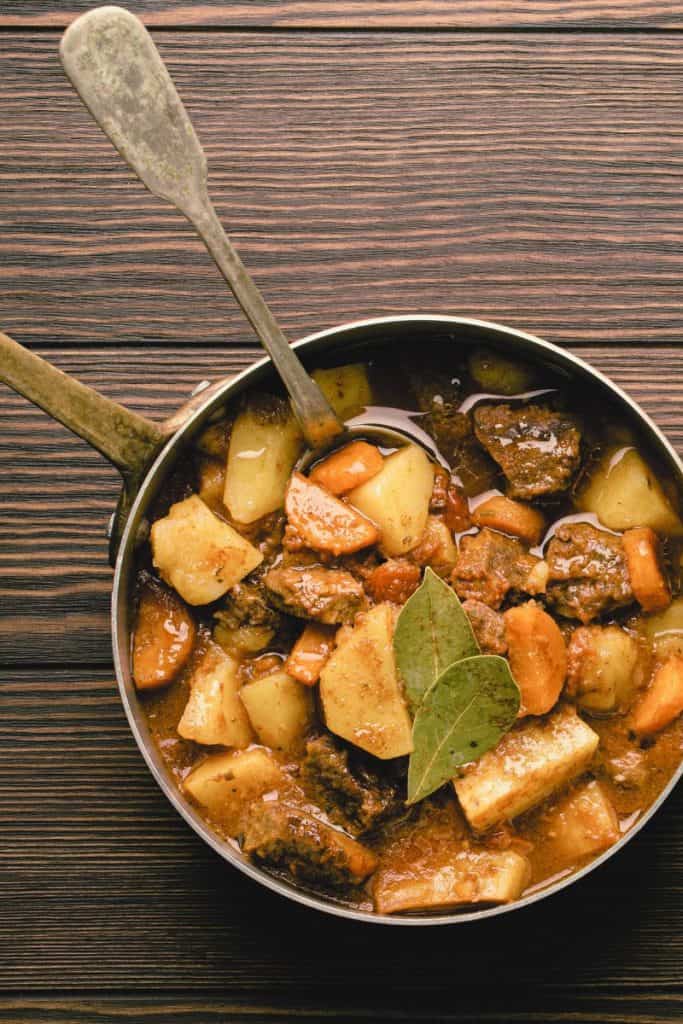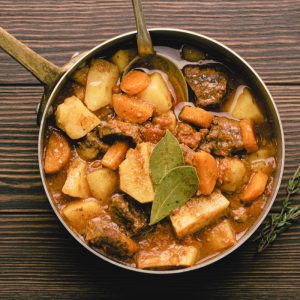Icelandic Lamb & Winter Vegetable Puree
What makes this stew feel truly Icelandic is the use of hearty, seasonal ingredients and simple, earthy flavors. Icelandic lamb is known for its rich, unique taste, partly because the sheep graze on wild herbs and grasses. When it’s slow-cooked in a stew like this, the meat becomes incredibly tender, and the flavors really shine. Root vegetables—like parsnips, rutabaga, and potatoes—are staples in Icelandic cooking during the colder months and are perfect for this kind of dish. They hold their flavour and texture beautifully in long-simmering stews, making them the ideal companions for the lamb.
Now, when it comes to how Europeans cook lamb compared to the Mediterranean or Middle Eastern styles, the key difference is the simplicity of the flavours. European stews like this one are all about letting the natural taste of the lamb take centre stage which makes them ideal for the delicate grassfed pastured meats we raise. There’s less focus on bold spices like in Mediterranean and Middle Eastern lamb dishes, which tend to feature ingredients like cumin, cinnamon, and citrus. European lamb dishes lean toward fresh, local herbs, garlic, and basic seasonings like thyme and bay leaves.

For vegetables, using heirloom varieties of rutabaga and small potatoes can really elevate the dish. These vegetables store well and develop a deeper, sweeter flavour over time, especially in winter. They’ve got the kind of earthy richness that complements the savoury lamb, making the stew feel extra comforting and satisfying.
Finally, when it comes to the difference between beef broth and beef stock, it’s all about depth. Stock is made by simmering bones for a long time, which releases collagen and gives it that rich, velvety texture. Broth, on the other hand, is usually lighter and made from meat (sometimes with bones), so its a bit more subtle. In this recipe, beef stock brings a deeper, more robust body to the stew, but if you don’t have stock on hand, broth will still work just fine.
This stew is one of those meals that warms you up from the inside out—perfect for a cozy winter night!
Icelandic Lamb & Winter Vegetable Stew with Root Veg Mash

Ingredients
- 450 g Boneless lamb shoulder cubed
- 2 tbsp olive oil
- 1 onion chopped
- 2 cloves garlic minced
- 2 carrots peeled, chopped
- 2 parsnips peeled, chopped
- 1 small rutabaga peeled, chopped
- 2 small potatoes peeled, chopped
- 4 cups beef broth
- 1 bay leaf
- 2 sprigs fresh thyme
- 1 tsp salt
- ½ tsp black pepper
- 250 g Potatoes peeled & cubed
- 125 g Parsnip peeled & cubed
- 125 g Swede/rutabaga peeled & cubeb
- 1 tbsp Unsalted butter
- 1/4 C Whole milk or cream
- Salt to taste
- Pepper to taste
Instructions
Sear the Lamb:
- Heat butter and olive oil in a heavy-bottomed pot over medium-high heat.
- Season lamb with salt and pepper, then brown in batches. Remove and set aside.
Sauté the Vegetables:
- In the same pot, add onion, leeks, carrots, and parsnips. Cook for 5 minutes until softened.
- Stir in garlic, then pour in white wine (if using) and let it reduce for 2 minutes.
Simmer the Stew:
- Return the lamb to the pot. Add swede, thyme, rosemary, bay leaf, and broth.
- Bring to a simmer, cover, and cook over low heat for 90 minutes, stirring occasionally.
Make the Root Veg Mash:
- While the stew simmers, boil potatoes, parsnips, and swede in salted water until fork-tender.
- Drain and mash with butter, milk (or cream), salt, and pepper.
Final Touches & Serve:
- Check stew seasoning, adjusting as needed. Remove thyme, rosemary, and bay leaf.
- Serve hot with a generous scoop of root veg mash.
Notes
- Icelandic Influence: The use of hearty, seasonal ingredients and Icelandic lamb, which is known for its rich, unique taste due to grazing on wild herbs and grasses.
- Simple European Cooking: European lamb stews focus on letting the natural flavor of the lamb shine with fresh herbs and garlic, unlike Mediterranean and Middle Eastern dishes that rely on bold spices.
- Heirloom Vegetables: Rutabaga, parsnips, and small potatoes are perfect for this stew as they store well, develop deeper flavor over time, and hold up in long-simmering dishes.
- Beef Stock vs. Broth: Stock is made by simmering bones for a long time, creating a rich, velvety texture, while broth is lighter and made from meat. Stock adds a deeper flavor to the stew, but broth can be used as a substitute.
- Winter Comfort: This dish is a perfect choice for a cozy winter meal, combining tender lamb and flavorful root vegetables for a comforting, savory stew.
